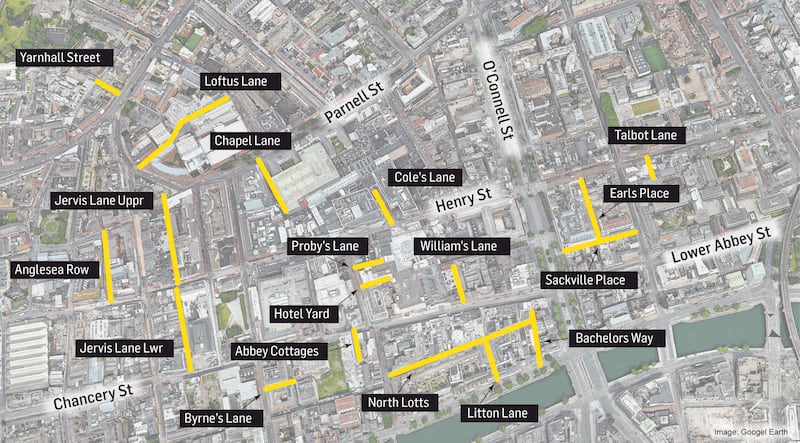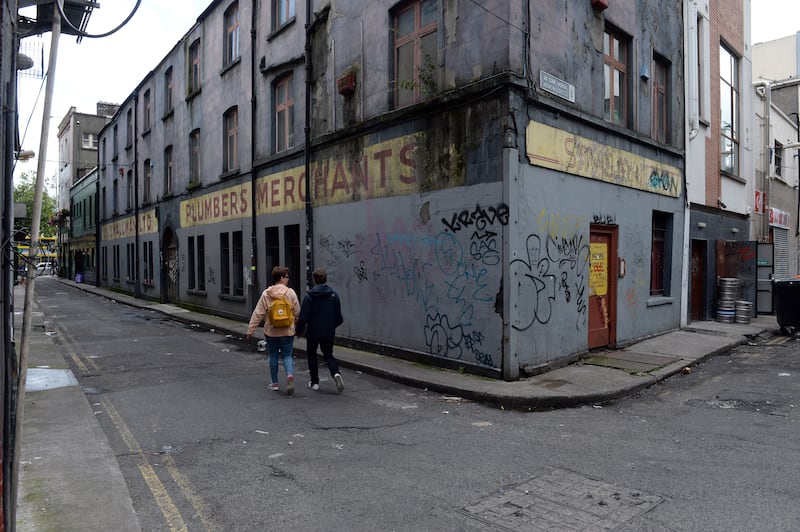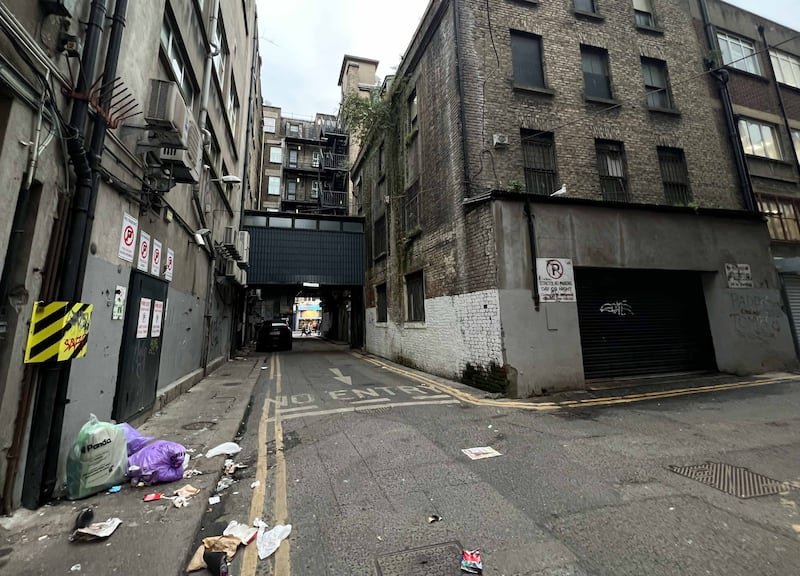Holidaymakers returning from European cities wax lyrical about the charming little laneways they explored, the warren of quirky shops they found down a tiny alley and the lovely cafe they discovered in a hidden cobbled courtyard.
Not so in Dublin. No one is romanticising their trip through Harbour Court from the Abbey Street Luas stop, or the lovely stroll they had along Litton Lane to the Liffey, and if they started to tell you about the fascinating experience they’d had in Jervis Lane, you might want to stop them before they went too far.
Dublin’s laneways are largely unloved service areas for bins, magnets for drug dealing and consumption, and illegal dumping, and increasingly branded no-go areas.
On Monday, Dublin city councillors agreed to close Harbour Court, an alley with entrances at Marlborough Street, Abbey Street Lower and Eden Quay on the northside of Dublin city centre, near O’Connell Street. It is largely used as a pedestrian link from the quays to Abbey Street but had become unsafe, with assaults, drug use and dumping.
READ MORE
Last August on the other side of the Liffey, the Aston Quay and Temple Bar Business and Residents Alliance appealed to the council to close several back lanes to address the “high levels of open drug dealing and street crime”.
Stephen Kennedy of Copper + Straw coffee shop, who chairs the alliance, said it continues to appeal for temporary closure of small lanes, not used by through traffic, until “there is a proper strategy for their regeneration”.
“The issues we’re having are identical to those in Harbour Court,” he says.
Following Harbour Court’s closure, speculation is turning where the alley axe might next fall.
Karl Mitchell, the city council’s executive manager with responsibility for the inner city, says the council doesn’t have a backstreet kill list.
“There is no policy to close lanes. This isn’t part of a bigger plan,” he says.
“We have closed a major problematic lane, for the moment. It doesn’t mean it’s closed forever, and we’re not rushing to close the rest of them.”
[ Drugs, violence and prostitution: The Dublin backstreet councillors had to closeOpens in new window ]
In fact, the council rarely closes streets and lanes in the city centre. The process of closing access to a road, known as the extinguishment of the public right of way, happens far more frequently in the suburbs, when requests are made by residents to close lanes behind houses if they feel vulnerable to break-ins or fly tipping.
In these cases, as with Harbour Court, the proposal is advertised by the council for public submissions, with the city councillors determining whether the closure goes ahead.
Last Monday when councillors approved the Harbour Court closure, they did so with regret and reluctance. Several councillors, who would not be considered shrinking violets, said they no longer felt safe using the lane, and so had no alternative but to agree to the closure to protect the public.
The Green Party’s Janet Horner was one of the few councillors to argue against the closure, branding the reduction in permeability and access through the city as regressive.
“My beef with the closure of Harbour Court is that it is a closure and nothing else, and that’s why I say it’s regressive. We aren’t closing it to start cleaning it up, or discuss ways we might animate it, make it a pedestrian priority space, pave it properly and make it more pleasant,” she says
“I know Karl says it’s not necessarily a permanent closure, but something like that can be very hard to reverse. It does seem that we’re saying ‘we’ve tried nothing and we’re all out of ideas’.”
However, Mitchell says, the council does have ideas for the city’s lanes. Reimagining Dublin One Laneways, a report by Seán Harrington Architects commissioned by the council six years ago, examined 18 laneways across the north inner city identified as unsafe or “underperforming”.
Of the 18, five pilot projects were chosen for specific improvement strategies. Short-term measures would include cleaning, lighting, the upgrade of street surfaces, repairing unkempt and vandalised facades, the removal of graffiti and fines for illegal parking.
In the medium-term these actions could be augmented by opening closed shopfronts and reactivating dormant spaces. Temporary events or “pop-ups” could be held, the report said.
Long-term measures would be more street-specific depending on the qualities of the laneway in question but would involve extensive refurbishment and development for a mix of residential use, shops, cafes, restaurants and cultural spaces.
“Any new development should help to make a pedestrian/cycling network for 24/7 permeability, in particular towards the Liffey. Cul-de-sacs would be transformed into throughways and routes without destination would be given purpose and meaning,” the report said.
“We would encourage pedestrian routes through private commercial premises to offer businesses additional frontages and opportunities, while creating destinations and shortcuts.”
The five were Cole’s Lane, Talbot Lane, Jervis Lane Upper, Abbey Cottages and Byrne’s Lane. If these names are unfamiliar that could be because little to no progress has been made on these projects.
“Covid did hold things up, but we are reinvigorating or restarting work on the Reimagining Dublin One project,” Mitchell says.
“Not because of the Harbour Court decision – we had already started some work on Cole’s Lane outside the Ilac Centre, and we are looking at Talbot Lane as part of a wider improvement on Talbot Street.”


The council is also considering developing North Lotts, which wasn’t one of the five pilots but was one of the 18 initial lanes, at an earlier stage than planned.
“North Lotts leads on to Liffey Street, which is currently undergoing regeneration, so there are definite opportunities there. North Lotts is a very similar shape to Harbour Court, with entrances from the quays through to Abbey Street, as well as the Liffey Street entrance,” says Mitchell.
Seán Harrington, who wrote the report for the council, is eager to see the laneways strategy get back on track.
“Right now is the time to really get the finger out and start developing these ideas,” he says. “As we become a society where more people live in apartments the public realm of the city is actually their garden.”
While Harrington looked at the treatment of laneways in international cities as part of his research, he says there is a successful and relatively recent example of laneways redevelopment right in the heart of the north inner city.
“The Millennium walkway is a real success and works as a template for all the other laneways.” Initially known as the Italian Quarter this restaurant and apartment enclave was created from derelict lands on the North Quays by developer turned MEP Mick Wallace just 20 years ago.
“There’s a magnet at both ends, the river at one end, and the Luas and the Jervis shopping centre at the other, and that gives the reason for people to walk through,” says Harrington.
“Secondly, the ground floor is active with lots of interesting cafes and shops so there’s people there 18 hours a day which makes it very unattractive for antisocial behaviour,” Harrington says.
“The next thing, really importantly, is people live there, giving 24-hour passive surveillance. Finally, it is permeable: it has exits on to other streets, so if you see someone you might be nervous of, you can get away.”
Harrington’s study did not include Harbour Court but he says, speaking generally, he would be reluctant to close laneways.
“The public realm should never be closed off, except as an absolute last resort. It’s ours as citizens,” he says.
“I would worry that closures could be the thin end of the wedge and be seen as a go-to solution, rather than taking a more holistic, creative view.”

- Sign up for push alerts and have the best news, analysis and comment delivered directly to your phone
- Find The Irish Times on WhatsApp and stay up to date
- Our In The News podcast is now published daily – Find the latest episode here

















